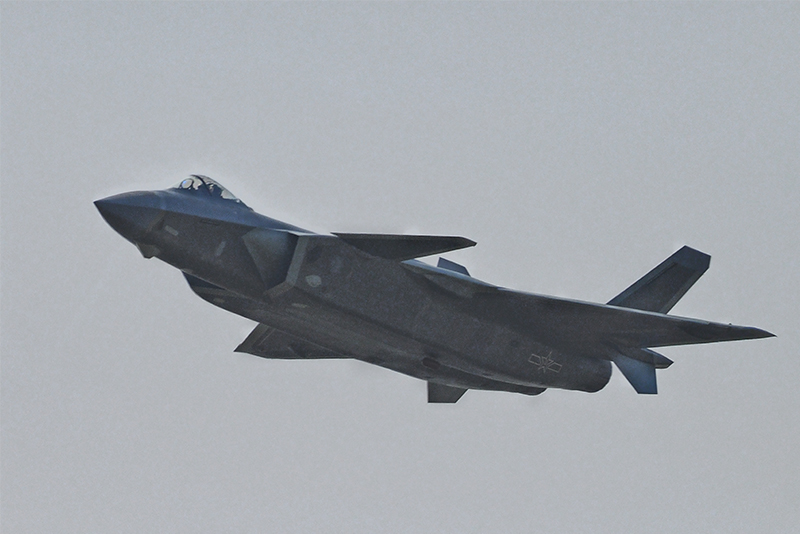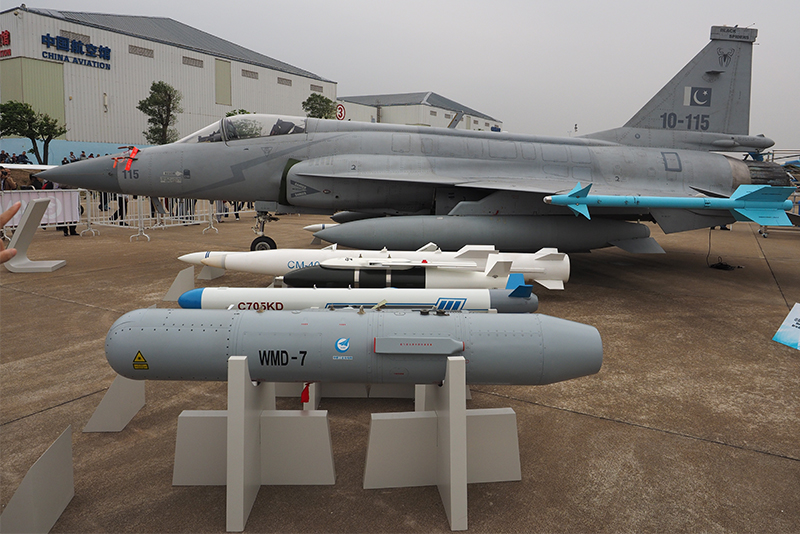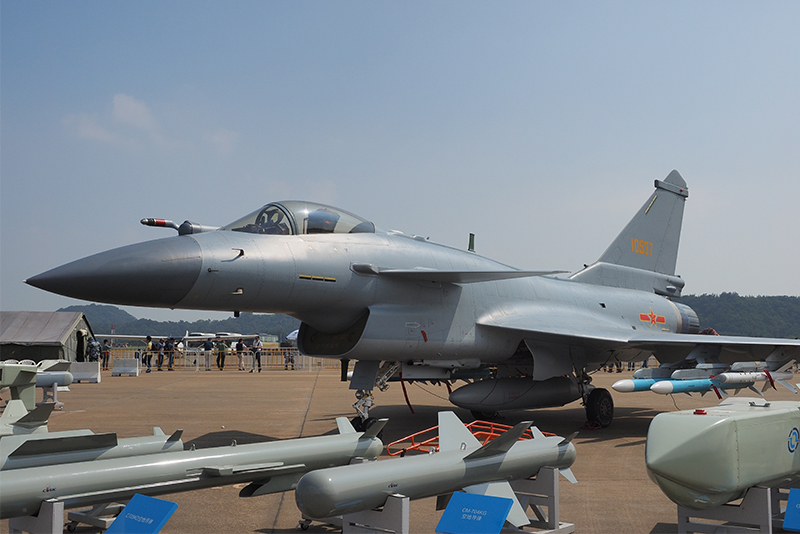
China’s military aviation industry today much advanced from that which relied on exports, although top-line engine production still holds it back.
The formation flight of five stealthy fifth-generation J-20 multirole combat aircraft over the Chinese capital of Beijing during the military parade commemorating the 70th year of the People Republic of China’s (PRC’s) founding on 1 October marks a watershed in indigenous fighter aircraft development.
It can be hard to believe that China’s military aerospace industries have advanced from reverse-engineering Soviet/Russian third- and fourth-generation aircraft to being one of only three nations – the two others being Russia and the United States – to be capable of developing and manufacturing aircraft of this class today.
Like many other contemporary military industrial powers, China’s goal for its nascent aerospace industry in the 1950s was eventual self-reliance and subsequently global exports. However, without an aviation history to base this on, it attempted to lay the foundations by acquiring foreign aircraft and subsystems, initially from the Soviet Union and re-engineering these to address knowledge gaps.
However, these early efforts were derailed by the isolation imposed by the Cultural Revolution and the subsequent freeze in Sino-Soviet relations. As a consequence of this unfavourable trinity of political chaos, underfunding and limited access to new foreign technology, earlier indigenously produced platforms and subsystems often suffered from long lead times in research and development (R&D) and poor quality control.
Industry consolidation
Since the early 1990s it has been apparent that China’s political and military leadership were displeased with the country’s inability to produce world-class products. In 1999 China reorganised its then 440,000-strong pool of state-employed aerospace engineers into two large corporate conglomerates, placing most military and large aircraft development in the Aviation Industry of China (AVIC) 1 and tasking AVIC 2 with development of trainers and helicopters, with the goal of spurring greater domestic competition. AVIC, however, turned out to be a monolithic bureaucracy that exercised control over still existing aircraft and component companies. As a result, redundancy became particularly acute.
Sweeping structural and financial reforms that followed changed the landscape of China’s military aviation industry. In 2008 and 2009 AVIC 1 and 2 were consolidated into present-day AVIC, with around 420,000 employees and 100 commercial and military aviation-related companies.
Since 2009, the corporation has brokered partnerships with local governments across China to improve its own capabilities as well as to spur private innovation. It has also imported high-precision and technologically advanced machine tools, electronics, and other components that can also be used in the production of military aircraft.
Reforms are focused on the adaptation of dual-use technologies for military purposes and accelerating capabilities through indigenous research and development programmes. Finally, government-led initiatives will also aim to enhance its presence in international markets, particularly in traditionally Western or Russian-dominated ones, to supply local industries with greater access to both dual-use technologies it requires and create additional funds that can be channelled towards defence R&D.
A notable aspect of the Chinese aviation industry is the close collaboration between the civilian and military aviation sectors, and the potential for commercial advances to fuel developments in the military sector. China’s defence industry has benefited from integration with China’s rapidly expanding civilian economy and science and technology sector, particularly elements that have access to foreign technology. Progress within individual defence sectors appears to be linked to the entwinement of each – through China’s civilian economy – into the global production and research and development R&D chain.
“China has invested heavily in new materials to enable lighter stronger airframes and that allow higher temperatures needed for high performance engines,” Colonel Fan Yang, a researcher at the PLA National Defense University, told AMR.
“[For example] the initial composite materials developed for use in the J-10 were tested by a foreign-sourced laboratory to ensure sufficient strength and durability,” Colonel Fan said, noting that domestic expertise composite material fabrication had grown due to concurrent activities in the commercial sector such as airline component production work that Airbus and Boeing had set up in China. An ability to build large composite material airframes and skin of satisfactory strength had contributed greatly improve China’s ability to produce stealthy fifth-generation aircraft designs, as well as modern, efficient civil and military transports.
Finally, several financial initiatives launched by the CCP government have allowed state-owned firms to tap on resources from other companies, internal funds, and foreign investment for product development. Analysts point to the FC-1 Xiaolong /JF-17 Thunder project, which was jointly developed by AVIC’s Chengdu Aircraft Industry Corporation (CAC) subsidiary and the Pakistan Aeronautical Complex (PAC) and subsidised by Pakistani funds. The collaboration was reasonably successful, with the Pakistan Air Force (PAF) procuring Block I and II single-seat JF-17 and two-seat JF-17Bs, while securing exports to Nigeria and Myanmar. Azerbaijan and Iran have also expressed strong interest in the type.

Indigenous progress
The Chinese fighter aircraft sector has made some remarkable advancement over the past 20 years. For example, CAC’s J-10 Menglong (Vigorous Dragon) programme conceived in the 1980s can be considered the most important domestic fighter project of the past two decades, representing a watershed moment for indigenous aerospace industry – even if Russian and Israeli assistance was suspected – when it entered People’s Liberation Air Force (PLAAF) service in 2003.
While deliveries of the J-10A have proceeded at pace over the intervening 10 years, deliveries of the initial model ceased around 2013 following the rollout of the improved J-10B, which has been provided with a strengthened airframe featuring a redesigned chin intake aimed at reducing weight and detectability, as well as a more powerful Russian-made Salyut AL-31FN Series 3 engine offering around 134.4kN of thrust.
In terms of radar and avionics, the J-10B has also benefited from a passive electronically scanned array (PESA) version of the original mechanically scanned KLJ-3 radar developed by the Nanjing Research Institute of Electronics Technology (NRIET), an electro-optical targeting suite comprising an infrared search and track (IRST) and laser rangefinder, as well as a rear-aspect missile approach warning system (MAWS).

The latest variant of the J-10 is the J-10C, which made its maiden flight in December 2013 and features a new active electronically scanned array (AESA) radar of unknown designation, improved avionics including a new datalink for the PL-15 beyond visual range anti-air missile (BVRAAM), and increased use of composite material in the airframe. The type entered service in April 2018.
In November 2018, a J-10B testbed equipped with the indigenously developed WS-10 engine with a thrust vectoring control (TVC) module from AVIC’s Shenyang-based Liming Aero-Engine Company was revealed to the public for the first time during the biennial Airshow China exhibition.
The WS-10 engine is a derivative of the model used to power the Shenyang Aircraft Company’s (SAC’s) J-11B fighter aircraft, a reverse-engineered copy of the twin engine Russian Sukhoi Su-27. The TVC nozzle has reportedly been developed not just for late model J-10 aircraft, but also as part of the new WS-15 engine program that is destined for the J-20.
Ultimately, more than 600 J-10s are expected to enter service with the PLAAF to eventually replace earlier models of the CAC J-7 fighter-bombers, which entered service in the late 1960s and early 1970s.
Simultaneously, Shenyang Aircraft Corporation (SAC) has apparently moved beyond its troubled twin-engine J-11B air superiority fighter programme, which is essentially derived from reverse-engineered technology from imported and locally assembled Russian Sukhoi Su-27 airframes to fielding the advanced J-16 strike fighter. The latest incarnation features substantial improvements including a reduced radar cross-section (RCS), a strengthened airframe and an improved AESA fire-control radar, as well as a new flight-control system, glass cockpit and the Liming WS-10B engine.
A new electronic warfare (EW) variant of J-16, known as the J-16D, was first sighted in December 2015. Featuring a shorter nosecone believed to house an AESA radar and large wingtip pods with vertical antennas, as well as the removal of the IRST and cannon for additional EW mission equipment and ventral antennas, the type is expected to enter service by around 2020.
Fifth-generation fervour
Known as the Weilong (Mighty Dragon), the twin-engine CAC J-20 was the first of the Chinese fifth-generation military aircraft developments to be officially acknowledged when a prototype completed a 21-minute maiden flight in January 2011, a revelation that had been carefully timed with the visit of then-US Secretary of Defense Robert Gates.
The baseline J-20 is a single-seat multirole fighter featuring canards for increased manoeuvrability and low-observability features such as twin, outward-canted, serrated edge landing gear doors, and an internal weapons bay. The J-20 is also equipped with a chin-mounted electro-optical targeting system (EOTS) that appears to be comparable to the one found on the Lockheed Martin F-35 Joint Strike Fighter.
Low-rate initial production (LRIP) aircraft are believed to have been fitted with the domestic WS-10B engine, although conflicting reports have also suggested that these LRIP aircraft feature a heavily modified version of the Russian 99M2 (AL-31FM2). However, it is known that serial production J-20s will be equipped with the domestic WS-15 engine that is believed to offer TVC and super-cruise performance.
Running concurrent to the development of the J-20 is the FC/J-31, or Shen Fei (Falcon Eagle). Although the existence of ‘another’ fifth-generation aircraft had been rumoured for more than a decade, it was not until late 2012 that the first images of what was later to become known as the FC/J-31 were published.
These images showed the single-seat FC/J-31 to be considerably smaller than the J-20, suggesting that it might make up the ‘low’ end of a ‘high-low’ fifth-generation capability mix with its larger stablemate. The general design characteristics of the FC/J-31 – low aspect-ratio wings and tailplanes of trapezoidal planform; chined fuselage, with forward-swept engine intakes; outward-canted twin vertical fins; and internal weapons carriage – are fairly typical of today’s crop of fifth-generation fighters, and indicate at least some degree of stealth.
As with the J-20, the FC/J-31 is a twin-engined design and is also currently powered by Russian turbofans (Klimov RD-93s) with an indigenous Chinese powerplant expected to be fitted for production-standard aircraft.
Engine conundrum
The chief weakness of China’s military aerospace industry remains its aero-engine sector, particularly its inability to mass-produce reliable high-performance turbofan engines to support contemporary and future aircraft developments. For example, the maiden flight in 1998 of the J-10 is thought to have been delayed by nearly two years, in part due to redesign work necessary to accommodate the Russian-made AL-31FN engine, rather than the intended domestic WS-10 engine.
However, even as the prospect of continued dependency on Russian engines remains likely for the near future, Chinese efforts into advancing indigenous jet engine technology is increasing. Most notably is the establishment of the state-owned Aero Engine Corporation of China (AECC) to address long-standing domestic capability shortfalls in commercial and military aero-engine development and production.

AECC was was formed by merging related AVIC subsidiaries, including AVIC Aero-Engine Controls, AVIC Aviation Engine (formerly Xian Aero-Engine Corporation), Sichuan Chengfa Aero Science and Technology, as well as unlisted companies such as the Liyang Aero-Engine Corporation and Liming Aero-Engine Manufacturing Corporation. It had a registered capital of $7.6 billion and a staff strength of approximately 96,000 workers during its inception.
According to official statements, AECC is responsible for the design, development, production, and support of military and commercial aircraft engines with a core focus on fixed-wing platforms although it will also support rotary aircraft engines as a secondary function.
The company launched a dedicated research institute, the Aero Engine Academy of China (AEAC), in December 2016. Based in Beijing, the new academy will lead the company’s R&D efforts and support nationwide efforts in aero-engine production.
AVIC said in a statement that the AEAC will accelerate domestic development of aero-engines and related technologies.
“This will be achieved through integrating [indigenous] aero-engine R&D capability, enhancing related manufacturing technologies and providing AECC with strong technical support,” the company stated.
Earlier this year, AECC announced during its supply-chain conference held in Jiangsu province from 20-21 May that it had grown its ability to source, build, and support aircraft powerplants by outsourcing component manufacturing to privately owned enterprises. The move is line with the CCP government’s desire to expand local private-sector participation in manufacturing commercial and military aero-engines
“In the past year the outsourcing of components continued to grow, quality control processes were effectively introduced, performance evaluations continued to be strengthened, and communication channels between AECC and its suppliers were smoother and more efficient,” the AECC said in a statement made through the State Administration for Science, Technology and Industry for National Defense (SASTIND).
Further plans are underway to deepen private-sector integration into national aero-engine supply chains and develop approaches to enhance production efficiencies and product quality.
“The [ultimate] goal is to stay on course on supply management, actively promote domestic supply-chain production and integrate military-civilian resources, and provide our armed forces with quality products and services,” Colonel Fan noted.
by Jr Ng












